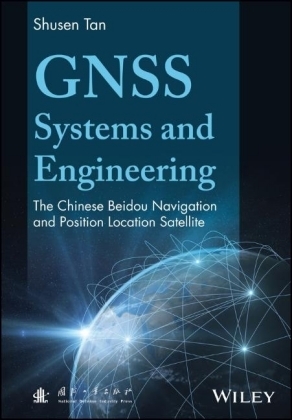
GNSS Systems and Engineering
John Wiley & Sons Inc (Verlag)
978-1-118-89703-4 (ISBN)
- Lieferbar (Termin unbekannt)
- Versandkostenfrei innerhalb Deutschlands
- Auch auf Rechnung
- Verfügbarkeit in der Filiale vor Ort prüfen
- Artikel merken
• The first book specifically describing the Chinese Beidou timing/navigation system – an increasingly important contributor to the GNSS
• Introducing the ‘user location information sharing’ demands, technologies and development trends
• Highlights the technical features and broad application prospects of navigation, positioning and short message communication of the Beidou satellite system
• Enhances understanding of the fundamentals and theories of radio navigation and positioning satellite systems
• Offers guidelines as to how to implement their design and construction
• A comprehensive reference on the subject for those who are doing scientific or engineering research in this area
Shusen Tan, Senior Engineer, Beijing Satellite Navigation Center, Beijing, China. Tan has been working in this area for over 20 years and his areas of expertise include the Construction and Application of China Beidou Radio Navigation and Positioning Satellite System, and Construction and Application of Global Navigation Satellite System (GNSS). In 2010 he was awarded with the Significant Contributions Person Award in Promoting the Development of China Satellite Navigation and Positioning Industry from Global Positioning System Applications Society. He is the Editor of three books (in Chinese) and author of 50 peer-reviewed journal and transaction full papers.
Preface xiii
1 Overview 1
1.1 Origin of GLONASS 2
1.1.1 Stage 1: Satellite Radio Positioning 2
1.1.2 Stage 2: RNSS 2
1.1.3 Stage 3: Satellite Navigation Positioning Reporting 3
1.2 Development and Future Plans for the GPS System 3
1.3 Development and Future Plans for GLONASS 5
1.4 Development and Future of the Chinese Navigation Satellite System 8
1.5 Galileo Navigation Satellite System 10
1.6 Indian Navigation Satellite System 11
1.7 Japanese Regional Navigation Satellite System 12
2 Concept and Application Prospects of Satellite Positioning Reporting Engineering 13
2.1 Satellite Positioning Reporting Service 13
2.2 Type of Service and Frequency Assignment 13
2.3 System Interference Analysis and Strategy 17
2.3.1 L Frequency Band Interference Analysis 17
2.3.2 S Frequency Band Interference Analysis 17
2.4 Service Optimization of Satellite Positioning Reporting Engineering 18
2.4.1 Integration of RDSS with RNSS and MSS 18
2.4.2 Integration of RDSS andWAAS 19
2.4.3 Integration of RDSS and TDRSS 19
2.5 RDSS Application 20
2.5.1 Aviation Application 20
2.5.2 Aerospace Application 21
2.5.3 Navigation Application 22
2.5.4 Land Transportation Application 22
2.5.5 Hazardous and Difficult Site Monitoring 22
3 Principles of Satellite Positioning Reporting 23
3.1 Theory of Positioning Reporting 23
3.2 Main Factors Affecting Positioning Accuracy 27
3.3 Accuracy of MCC Time Delay Measurement 27
3.4 Space Propagation Time Delay Error 28
3.5 Geometric Figure and Positioning Accuracy 29
3.6 User Elevation and Positioning Accuracy 30
4 Engineering Design of the Satellite Positioning Reporting System 33
4.1 System Composition 33
4.2 System Function Design 33
4.2.1 Outbound Function Design 34
4.2.2 Inbound Function Design 36
4.2.3 System Processing Capability 36
4.3 System Technical Index Design 37
4.3.1 System Coverage Area 37
4.3.2 System Capacity Design 37
4.3.2.1 System Outbound Capacity Design 38
4.3.2.2 System Inbound Capacity Design 38
4.3.3 System Positioning Accuracy Design 40
4.4 Signal System Design 41
4.4.1 Outbound Signal Design 41
4.4.2 Inbound Signal Design 43
4.5 System Frequency Design 43
4.5.1 Influence of the Frequency Stability of a Transponder on System Performance 44
4.5.2 Satellite-Ground Frequency Adjustment 44
4.6 Engineering Design of Positioning Reporting Satellites 45
4.6.1 Excellent Capability of Beam Coverage 45
4.6.2 Design of EIRP and G/T Value 46
4.7 MCC Engineering Design 48
4.7.1 MCC Outbound Link Design 49
4.7.2 MCC Inbound Link Design 49
4.7.3 Satellite Orbit Determination and Prediction 50
4.7.4 Dual-SatelliteWide Area Differential Processing 51
4.7.5 MCC Service Processing 53
4.8 RDSS Application Terminal Design 54
4.8.1 Single Address User Receiver 54
4.8.2 Multi-Address User Receiver 55
4.8.3 RDSS Double-Model User Receiver 55
5 Comprehensive Theory of RDSS and Engineering Design 57
5.1 Definition of CRDSS 57
5.2 Theory of CRDSS 58
5.2.1 Navigation Position Reporting Service 58
5.2.2 RNSS Continuous Navigation Service 59
5.2.3 Mission Comparison between CRDSS Service and RNSS Service 60
5.2.4 CRDSS System Position Reporting Capability Analysis 61
5.2.5 CRDSS Global Coverage Analysis 62
5.2.6 Realization of the CRDSS Personalized Service 64
5.3 CRDSS system Engineering Design 65
5.3.1 Application Object and Design Principle 65
5.3.1.1 Application Objects 65
5.3.1.2 Design Principle 65
5.3.2 Constellation Selection and Coverage Area Design 66
5.3.2.1 Constellation Selection 66
5.3.2.2 CAT-I Integrity Broadcasting Constellation Design 67
5.3.2.3 Air Traffic Control Coverage Area Design in the Region of China 68
5.3.2.4 CRDSS Coverage Area Design 68
5.3.3 Precision Analysis and Index Distribution 70
5.3.3.1 Total Precision Requirement 70
5.3.3.2 Observation Equipment Error Analysis 71
5.3.3.3 Point Positioning and Single Reference Station Differential Positioning Error Analysis 71
5.3.3.4 Base Network Pseudorange Differential Positioning Accuracy Analysis 72
5.3.3.5 Single Reference Station Carrier Phase Differential Positioning Error Analysis 74
5.3.3.6 Narrow Correlation Pseudorange Differential Positioning Accuracy Analysis 77
5.3.4 Selection of Precision Positioning Scheme 78
5.3.5 Guidance Service 78
5.3.6 Two-way Data Transmission Link Design of the S/L- Frequency Band 79
5.3.6.1 Design Condition and Design Item Parameters 79
5.3.6.2 Estimation of Outbound Link Level and Capacity 79
5.3.6.3 Estimation of Inbound Link Level and Capacity 80
5.4 CRDSS Navigation Positioning Satellite 82
5.4.1 Mission and Functional Parameter 82
5.4.2 RNSS Satellite 83
5.4.3 CRDSS Satellite 83
5.4.3.1 Regional CRDSS Satellite 83
5.4.3.2 Global CRDSS Satellite 87
5.5 CRDSS Ground System 88
5.5.1 Function and Composition of Ground System 88
5.5.2 Measurement and Control Center (MCC) 89
5.5.2.1 CRDSS Service User Distance Measurement and Positioning Equation 89
5.5.2.2 Distance Measurement System Scheme 90
5.5.3 GNSS Reference Station System 92
5.5.3.1 Local Class I Precision Approach Reference Station System 93
5.5.3.2 The 1.0 m Level Reference System 93
5.5.4 Multiple System Satellite Clock Error Determination 93
5.5.4.1 Compass Satellite Clock Error Determination 94
5.5.5 Multiple System Satellite Precise Orbit Determination and Application 95
5.5.6 Formation and Application of Ionosphere Correction Parameter 96
5.5.7 GNSS High-Accuracy Real-Time Dynamic Positioning 97
5.5.8 CRDSS High Accuracy Quasi Real-Time Positioning 98
5.6 Typical Application Scheme 99
5.6.1 High Accuracy Pseudorange Double Difference Application Scheme 99
5.6.1.1 Pseudorange Double Difference RDSS Positioning Principle 99
5.6.1.2 Pseudorange Double Difference RDSS Positioning Distance and Observation Parameters Correction and Precision Analysis 101
5.6.1.3 L Frequency Band Double Difference Distance Correction 103
5.6.1.4 Pseudorange Double Difference RDSS Positioning Accuracy Estimation 104
5.6.1.5 MCC Total Distance Measurement Scheme 105
5.6.2 Design Scheme of the Double Module User Terminal 106
6 Anti-Interference and Low Exposure Technology of the Satellite Positioning User 111
6.1 Self-Adaptive Spatial Filtering Principle 111
6.2 Basic Algorithm of Self-Adaptive Filtering 112
6.3 Self-Adaptive Nulling Antenna Engineering Design 115
6.4 Low Exposure Transmission Array Antenna Design 115
7 Concept of Satellite Navigation and the Principle of Positioning and Velocity Measurement 117
7.1 Concept of Satellite Navigation 117
7.2 Satellite Navigation Principle 119
7.2.1 Solutions of the Navigation Mission 121
7.2.2 Concept and Definition of the Pseudorange 122
7.2.3 Navigation Positioning Equation 123
7.3 Geometric Precision Factor 125
7.4 Satellite Navigation Velocity Measurement Principle 127
7.5 Positioning Velocity Measurement Precision 129
7.5.1 Positioning Accuracy of Global System 130
7.5.2 Global and Regional Augmentation System Positioning Accuracy 130
7.5.3 Global, Regional, and Local Augmentation Positioning Accuracy 130
7.6 Distance Difference and Radial Velocity Difference 130
7.7 Combined Method 131
7.8 Carrier Phase Difference Method 131
8 Performance Demand and General Design of RNSS 133
8.1 Essential Performance of RNSS 133
8.1.1 Value-Added Performance of RNSS 139
8.1.2 High-Dimensional Performance of RNSS 140
8.2 Mission and Procedure of the General Design 141
8.3 Mission and Procedure of Engineering Design 143
9 SystemDesign of Satellite Navigation 145
9.1 System Design Principle and Content 145
9.1.1 System Design Principle 146
9.1.1.1 Adhering to the Long-Term Duty and Continuity 146
9.1.1.2 Adhering to Coordination and Integration 146
9.1.1.3 Laying Emphasis on Economy and Technical Feasibility 146
9.1.1.4 Security and Competitiveness 147
9.1.2 System Design Content 147
9.2 Service Mode and Content 148
9.3 Satellite Orbit and Constellation Selection 150
9.3.1 Orbital Altitude 150
9.3.2 Track of Sub-Satellite Point and its Effect on Measurement and Control Plan 152
9.3.3 Orbital Plane and the Number of Constellation Satellites 154
9.3.4 Selection of Types of Satellite Orbits 158
9.4 Signal Frequency and Modulation Coding Mode 160
9.4.1 Selection Principle of Navigation Signal Frequency 160
9.4.2 Navigation Frequency Recommended by the ITU 160
9.4.3 Signal Frequency and Bandwidth Selection 164
9.4.4 Satellite Multiple Access Identification and Ranging Code Design 166
9.4.5 Navigation Signal Modulation Methods 173
9.4.5.1 Binary Offset Carrier (BOC) Modulation 175
9.4.6 Selected Error Correction Coding of Navigation Message 179
9.4.7 Advocates of the Compass Operators Toward Satellite Navigation Frequency Compatibility and Compass Signal Structure 181
9.5 Time Standard and Timing Pattern of Satellite Navigation 182
9.5.1 Satellite Navigation Time System (SATNAVT) 183
9.5.2 Universal Time (UT) (Greenwich Mean Solar Time) 183
9.5.3 Universal Time Coordinated (UTC) 183
9.5.4 Julian Period 184
9.5.5 Timing Method of Satellite Navigation Time (SATNAVT) 184
9.6 Navigation Satellite Trajectories and Ephemeris Expressions 186
10 Design of the Satellite Navigation Operation Control System 193
10.1 Mission and Composition of the Satellite Navigation Operation Control System 193
10.2 Satellite Time Synchronization and Timing 194
10.2.1 Method of Satellite-Ground Time Synchronization 194
10.2.1.1 Method of Satellite-Ground Pseudorange Time 194
10.2.2 Method of Inter-Station Time Synchronization 195
10.2.2.1 Method of Two-Way Satellite Time Transfer 196
10.2.2.2 Method of Two-Way Satellite Common View 196
10.2.2.3 Method of Two-Way GEO Satellite Common View 196
10.2.3 User Timing Service 197
10.2.3.1 Prediction Model for the Satellite Clock Error 197
10.3 Correction of Navigation Signal Spatial Propagation Delay 198
10.3.1 Ionosphere Model Correction for Single Band Users 200
10.3.1.1 Ionosphere Correction in Regional Grid 202
10.4 Determination of Precise Orbit and Satellite Clock Error 203
10.4.1 Correction of Satellite Orbit 204
10.4.2 Accuracy Estimation 205
10.5 IntegrityMonitoring and Prediction 206
10.5.1 Satellite-Ground Two-Way Pseudorange Time Synchronization Separated Satellite Integrity 206
10.5.2 Integrity of DLL Related Monitoring Satellite Payload 207
10.5.2.1 How to Conduct the Distortion Determination of Satellite Signals 207
10.6 Integration of Operation Control System 209
10.6.1 Combination of RNSS and RDSS to Realize Integration ofThree Functions of Navigation, Communication, and Identification 209
10.6.1.1 Basic Principles and Methods of Integration 209
10.6.1.2 Performance Features of RNSS and RDSS Integration 210
10.6.2 Realization of Integration with a Foreign System by Multiple-System Information Fusion 210
10.7 Operation and Control of Multi-System JointWide Area Augmentation System 211
10.7.1 System Composition 212
10.7.2 SystemWorking Principle 213
10.7.3 GEOS Satellite Correction Parameters and Integrity Broadcast Message 216
10.7.4 Satellite IntegrityMonitoring 217
10.7.5 Composition of the Monitoring Station 218
10.7.6 Master Control Station JointWide Area Differential Software Function 220
11 Navigation Satellites and Navigation Payload 225
11.1 Satellite and Navigation Payload History 225
11.2 Navigation Satellite Platform 229
11.3 Navigation Payload Requirements 232
11.4 GPS Satellite Navigation Payload 232
11.4.1 Atomic Frequency Standard 233
11.4.2 On-Board Processing 233
11.4.3 Wave Band System 234
11.4.4 Horizontal Link 235
11.4.5 Autonomous Navigation 235
11.5 GLONASS Navigation Satellite and Navigation Payload 238
11.5.1 Functions of the GLONASS Navigation Satellite 238
11.5.2 Satellite Composition 239
11.5.2.1 Navigation Transmitter 239
11.5.2.2 Time System 240
11.5.2.3 Control Combination System 241
11.5.2.4 Orientation and Stable System as well as Its Auxiliary Equipment 242
11.6 Galileo Navigation Satellite and Alternative Schemes of Navigation Payload 242
11.6.1 Satellite Definition 242
11.6.2 MEO Satellite Configuration 244
11.6.3 Payload of MEO Satellite Navigation 246
11.6.4 GEO Satellite and Navigation Load 247
11.7 Compass Satellite Navigation and Payload 248
11.8 Comparison and Development Direction of Navigation Payload 249
12 Satellite Navigation User Receiver 251
12.1 Relative Motion Characteristics Between the User and the Satellite 251
12.2 PseudorangeMeasurement and Error Analysis 256
12.2.1 Types and Characteristics of Pseudorange Error 257
12.2.2 Dynamic Stress Error 258
12.2.3 Pseudorange Random Error 258
12.2.4 Pseudorange Smoothing Technology 260
12.3 Positioning and Filtering Processing 261
12.3.1 α/β Tracker 261
12.3.2 Kalman Filter 265
References 271
Further Reading 273
Index 275
| Erscheinungsdatum | 13.06.2018 |
|---|---|
| Verlagsort | New York |
| Sprache | englisch |
| Maße | 175 x 246 mm |
| Gewicht | 658 g |
| Themenwelt | Naturwissenschaften ► Geowissenschaften ► Geografie / Kartografie |
| Technik ► Elektrotechnik / Energietechnik | |
| Technik ► Nachrichtentechnik | |
| ISBN-10 | 1-118-89703-X / 111889703X |
| ISBN-13 | 978-1-118-89703-4 / 9781118897034 |
| Zustand | Neuware |
| Informationen gemäß Produktsicherheitsverordnung (GPSR) | |
| Haben Sie eine Frage zum Produkt? |
aus dem Bereich


